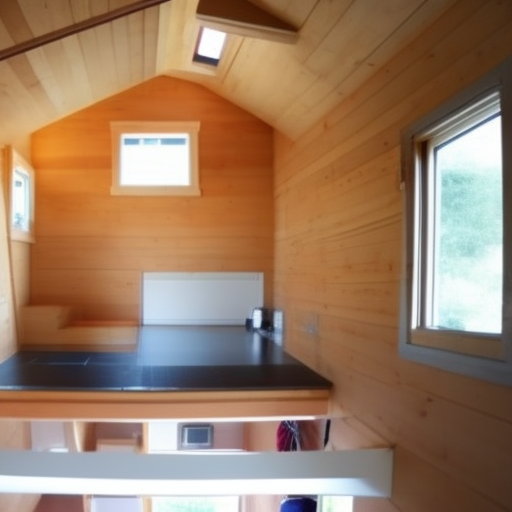From cozy cabins to picturesque shepherds’ huts, tiny houses are all the rage! But when you go up the stairs and into a tiny house’s loft, is the floor thick enough for you to feel secure and safe? Let’s take a look into how thick the floor in a tiny house loft really is.
Measuring Loft Floor Thickness
When it comes to your tiny house loft, the thickness of the floor is important for both comfort and safety. Nobody wants to feel like they are walking on a flimsy surface, or worse, have their floor collapse beneath them! So, how do you measure the thickness of your loft floor? Here are some steps to follow:
First, remove any carpet or flooring materials from the surface of your loft. This will give you a clearer view of the structure below. Next, locate the support beams beneath the floor. These are the wooden or metal beams that run perpendicular to the floor joists. Measure the distance from the top of the support beam to the top of the floor joist. This will give you the thickness of your floor. Of course, if you don’t have access to the underside of your loft, you can also take measurements from above using a ruler or tape measure.
Keep in mind that the thickness of your loft floor will vary depending on the materials used and the design of your tiny house. Some tiny home builders may opt for thicker floors for added durability, while others may prioritize lighter weight to maximize mobility. It’s important to consider your own needs and preferences when designing your tiny home loft. A thicker floor can provide greater insulation and noise reduction, but it may also reduce headroom and storage space. Ultimately, finding the right balance between comfort and functionality is key to creating a comfortable and personalized living space within your tiny home.
Benefits of Thicker Flooring
When it comes to designing your tiny house loft, the thickness of your flooring might seem like an afterthought. But let us tell you, a thicker flooring can actually make a huge difference in the livability of your tiny home. Here are some benefits to consider:
– **Insulation:** Thicker flooring means more insulation. This can help keep your tiny home warmer in the winter and cooler in the summer. It can also help absorb sound, making it quieter and more peaceful inside. Plus, insulation can save you money on heating and cooling costs in the long run.
– **Durability:** A thicker floor will be more durable and long-lasting. This is especially important in a tiny home where every inch of space is utilized, and you don’t want to have to redo your flooring any time soon. Plus, a strong floor can better support your furniture and appliances, making your tiny home feel more sturdy and secure.
Imagine this: you’ve just moved into your tiny home and you’re unpacking your belongings. You accidentally drop a heavy box on the floor, but because your flooring is thick and durable, it barely even leaves a scratch. Or maybe it’s the dead of winter and you’re snuggled up inside, enjoying a cup of hot cocoa. You feel a draft and think, “Uh-oh, I’m going to freeze!” But then you realize that your thick flooring is keeping the cold air out, and you’re snug as a bug in a rug. These are just a few examples of how investing in thicker flooring can benefit your life in a tiny home.
Common Loft Flooring Options
When it comes to choosing the right loft flooring, there are quite a few options you can go for. One popular choice is hardwood flooring, which is not only durable but also visually appealing. It can give your tiny house a warm and rustic feel, creating a cozy atmosphere that you’ll love. With hardwood flooring, you can also choose from different wood species such as oak, maple, and cherry, each with its own unique grain pattern and color.
Another common loft flooring option is laminate flooring, which is easier to install and maintain compared to hardwood flooring. It is also more affordable and comes in a wider variety of designs and colors. Laminate flooring can simulate the look of hardwood, stone, or tile, allowing you to customize your tiny house loft to your liking. Plus, laminate flooring is resistant to scratches and stains, making it ideal for high-traffic areas. With these two great options, you can choose the one that works best for your lifestyle and budget.
Installation Considerations
When it comes to installing a floor in your tiny house loft, there are a few things to consider. Firstly, you need to decide on the type of material you want to use. Some popular options include hardwood, bamboo, and laminate. Hardwood is a popular choice because it’s durable and can last a long time. Bamboo is also a popular option because it’s eco-friendly and sustainable. Laminate, on the other hand, is a more affordable option that’s easy to install.
Once you’ve decided on the material, you’ll need to think about the installation process. Do you want to do it yourself, or hire a professional? If you’re a DIY enthusiast, installing a new floor in your tiny house can be a fun and rewarding project. However, if you’re not confident in your DIY skills, it’s best to hire a professional to ensure everything is done correctly. At the end of the day, the most important thing is that your new floor is installed correctly and safely. With a little bit of preparation and planning, you can have a beautiful, functional loft floor that complements your tiny house perfectly. So, as you can see, floor thickness in a tiny house loft is a complex topic that truly depends on the materials and construction used. With the right materials and expert installation, you can achieve a safe and comfortable floor thickness – no matter how tiny your house may be!